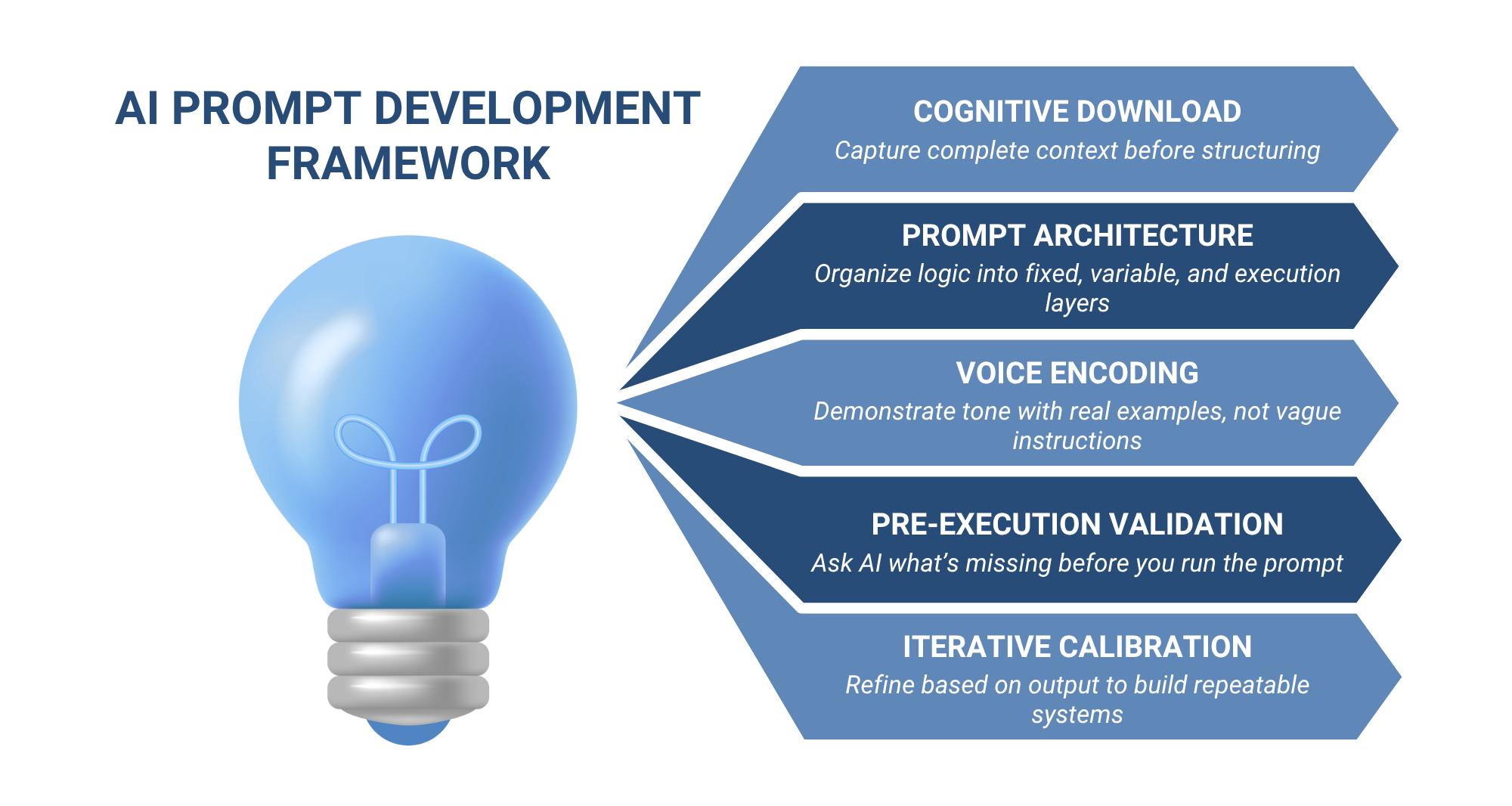How to Turn Raw Ideas into High-Converting Results: A 5-Step System for AI Prompt Development
AI tools provide speed, precision, and scalability, but many teams face challenges after deployment. Despite impressive demonstrations, daily use often exposes gaps. Reports need revision, strategic insights fall short, and client deliverables require several edits before completion.
It is easy to blame technology or assume more training will solve these issues. However, the main challenge is that organizations often treat AI prompt development as a creative instinct instead of a technical discipline that requires structure, clarity, and consistent logic.
Your team has valuable expertise in market insight, stakeholder priorities, compliance, and operations. However, this knowledge often stays within established routines and discussions, making it unavailable to the AI systems meant to use it.
Bridging this gap requires translation, not creativity. A systematic approach to AI prompt development turns dispersed expertise into clear, actionable instructions that AI can follow reliably. This change replaces trial-and-error with a scalable process that improves output, strengthens strategy, and builds competitive advantage.
Why Unstructured Prompting Slows Everything Down

Many professionals use AI tools like search engines, entering incomplete ideas, and expecting accurate results. While this may work for simple information retrieval, it is ineffective for generating new content, such as reports, strategies, or client deliverables.
For example, a professional preparing an important document may understand their objectives but struggle to communicate them clearly to the AI. They revise prompts repeatedly, spending significant time without achieving the desired outcome.
When this inefficiency affects an entire team, the cumulative time loss is significant. More importantly, it prevents AI from serving as the strategic partner it is intended to be.
To improve, teams should move beyond experimentation and adopt a structured approach. Prompting must be treated as a core skill rather than a personal trial-and-error process.
A Five-Part Framework for AI Prompt Development
To move from scattered experimentation to strategic execution, teams need a repeatable system. These five steps offer a framework for turning expertise into clear, actionable AI instructions.

Step 1: The Cognitive Download
Effective prompts begin by capturing all relevant information before organizing it. This cognitive download transfers essential knowledge from your mind to the page.
At this stage, focus on gathering comprehensive context over structure. For example, when preparing prompts for strategic documents or client communications, consider including:
- Strategic context
- Audience insight
- Operational details
- Voice and tone
This step is especially valuable when critical knowledge is held by only a few individuals. Clear documentation turns this knowledge into assets that others and AI can use. Clarity and completeness here are essential for effective AI prompt development.
Step 2: Building the Logic Behind the Prompt
Once you have the raw information, organize it by identifying patterns and establishing a clear structure for AI to follow.
Ask yourself:
- What does AI need to know before it can act?
- What stays the same across outputs, and what changes?
- Where are the decision points, and what guides them?
Next, incorporate three layers into your prompt:
- Foundational parameters – These are the fixed elements: your brand voice, compliance rules, and strategic positioning.
- Contextual variables – These shift depending on the task: audience type, format, and specific goals.
- Execution logic – This specifies how the AI processes information, makes decisions, and shapes the final output.
With this structure, your prompt becomes a system. Each component serves a clear purpose, producing outputs that are predictable, repeatable, and aligned with your goals.
Teams that build this architecture rely on strong frameworks, save time, and achieve better results.
Step 3: Encoding Voice and Expertise
A common oversight in prompt development is failing to instruct AI on your organization’s communication style. General directions such as “write professionally” or “use a strategic tone” often lead to generic results that require significant editing.
To improve output, treat voice as a technical input, not just a stylistic preference. Provide clear examples of your organization’s communication style:
- Use real sentences from approved materials to highlight your phrasing, structure, and word choices.
- Include signature phrases that signal authority, urgency, or strategic thinking.
- Share examples of how you explain complex ideas, back up claims, and build logical arguments.
Clear guidance enables AI to adopt both your messaging and voice. This consistency is crucial across teams and deliverables. In advanced AI prompt development, voice is integral to the system, not just a style guide.
Step 4: Pre-Execution Validation
Even well-crafted prompts need review before use. One effective approach is to ask AI what additional information it needs. Before running your prompt, add a question such as:
“Review these instructions. What additional information would improve the accuracy and relevance of your output? What ambiguities could affect results?”
This step often reveals gaps from assumptions or overlooked details. AI may highlight unclear audience expectations, missing format requirements, or vague strategic goals.
Use this feedback to refine your prompt by adding examples, clarifying structure, and providing context. This practice improves quality and helps your team understand what AI needs to perform well. Building this habit is essential for advanced AI prompt development, where precision and clarity drive better results.
Step 5: Iterative Calibration
After running your prompt, continue refining it. This process turns good prompts into great ones.
Review the output with clear criteria:
- Accuracy – Are the facts correct? Is the logic sound?
- Relevance – Does every part support the goal? Is anything off-topic?
- Voice – Does it match your organization’s tone and phrasing?
- Strategic alignment – Does it move your business forward? Could the positioning be stronger?
Record what worked and what did not. Link each issue to the prompt, adjust wording or add context, and re-run to evaluate improvements.
Over time, this process builds a library of proven prompt frameworks for proposals, training guides, strategy documents, and more. Your team can then rely on established systems for consistent results.
Real-World Application: Investfest 2025
At AI InnoVision, we apply structured prompt development into action. During Investfest 2025, our CEO Alicia Lyttle showed how this approach turned a decade of raw content into scalable business tools.
Watch the full conversation to see how Alicia Lyttle used structured prompt development to turn a decade of ideas into scalable business assets. The Investfest 2025 interview explains how to design and implement custom AI solutions without technical expertise.
Key lessons from the conversation include:
- Start with business goals, not just what AI can do.
- Give AI full context: your assets, audience, and market position.
- Use structured prompts to uncover options you might not see on your own.
When organizations approach AI with clarity and discipline, they gain more than content creation. They can model decisions, explore strategies, and develop tools that scale their expertise.
The Strategic Imperative
Structured AI prompt development is not just a technical upgrade; it represents a strategic shift. When teams use this five-part framework, they move from treating AI as a reactive tool to leveraging it as infrastructure that scales expertise, accelerates execution, and strengthens decision-making.
This approach delivers more than operational efficiency. It builds institutional knowledge, aligns output across teams, and positions organizations to take full advantage of future AI capabilities. When prompt development becomes systematic, it creates a repeatable process that turns expertise into action consistently and at scale.
Importantly, this is not about replacing people. It is about building systems that enable better thinking, faster delivery, and smarter strategy.
The method is proven, the tools are available, and the opportunity is real.
What matters now is how you put it into practice.




